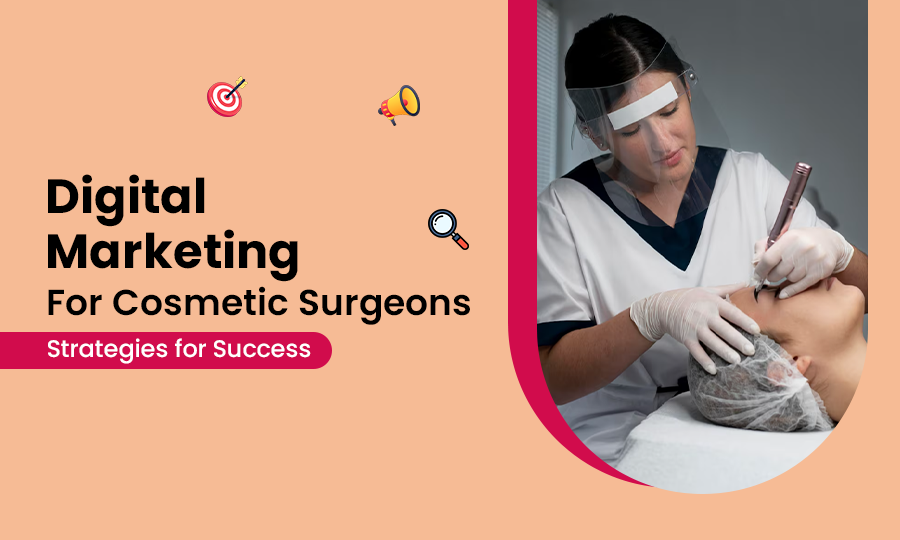Imagine a person scrolling through Social Media or Googling terms like “Best nose job near me,” and the name of your business appears at the top position in the SERPs. Wouldn’t it be so great? By implementing effective digital marketing for cosmetic surgeons, you can not only outshine your competitors but also bring your business to the top.
Remember, your digital footprint is the first impression of your business. How you present your business online matters. Did you know, 2/3 of all patients research on the Internet before consulting a healthcare provider. By establishing a strong and positive online presence, cosmetic surgeons can foster trust among prospective patients.
This blog will offer a complete guide on how digital marketing can benefit cosmetic surgeons and some digital marketing strategies you must consider to attract high-quality leads and grow your business online.
What is Digital Marketing for Cosmetic Surgeons?
Cosmetic surgery digital marketing means implementing online strategies to build brand awareness, successfully reach new patients, and drive conversions. These strategies include Search Engine Optimization (SEO), Social Media Marketing (SMM), PPC advertising, website optimization, content writing, and more.
However, with the increasing number of cosmetic surgeons, the competition is getting fiercer with time. But by incorporating these strategies, a cosmetic surgeon can not only grow their practice but also enhance the online visibility of their business.
How Digital Marketing Can Be Beneficial for Cosmetic Surgeons
Still not convinced? Here are some of the major benefits of investing in digital marketing.
- Boost Visibility
Cosmetic surgeons must keep their patients hooked in order to maximize website traffic and get more appointments. By leveraging social media platforms, you can make your ads or posts reach a large number of patients.
Maintaining a strong online presence on various digital platforms can help patients find relevant cosmetic surgery practices and encourage them to share it with their friends and followers.
- Precisely Target Prospective Patients
Unlike traditional marketing methods such as TV ads and newspaper ads, digital marketing allows cosmetic surgeons to precisely target their audience. It plays a huge role in effective patient acquisition and retention.
When compared to traditional marketing approaches, digital marketing offers a higher ROI and is great for individuals who have recently started a clinic.
- Gain Credibility and Trust
Many clinics promote their cosmetic surgery services and products online. By showcasing patient success stories and client testimonials, cosmetic surgeons can gain the trust of potential patients.
With more and more patients becoming cautious of unqualified clinics and negative consequences, establishing a strong online presence is crucial for cosmetic surgeons. Effective digital marketing efforts can help cosmetic surgeons win over their potential patients’ trust and establish themselves as authoritative cosmetic surgery resources.
- Enhance Brand Awareness
Nowadays, cosmetic surgery is becoming more and more popular. And with this popularity, the competition is also getting fiercer.
By investing in digital marketing campaigns, cosmetic surgeons can spread awareness of their business among both prospective patients and locals who are based in the proximity of their clinic.
Digital marketing is especially great for cosmetic surgeons who are based in big cities. Furthermore, online marketing can make your audience become familiar with your products and services and foster trust among them.
Digital Marketing Best Practices: 9 Must-Follow Steps for Cosmetic Surgeons
Now that we have discussed the benefits of implementing digital marketing, let us focus on the best practices of digital marketing that you can consider for achieving successful outcomes.
Step 1: Build a Strong Foundation – Your Website
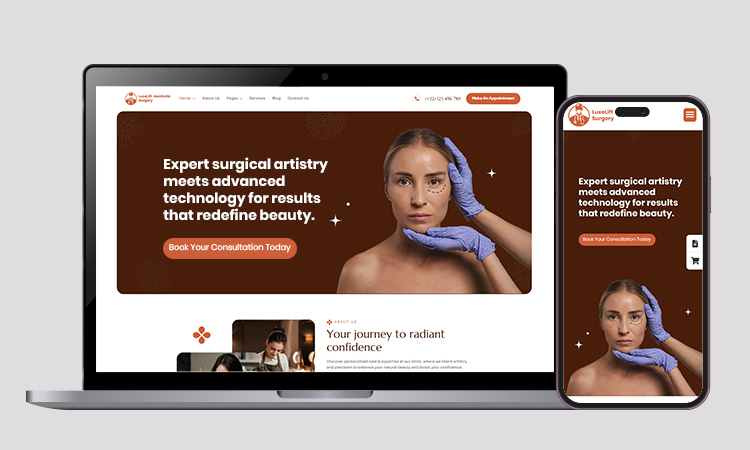
Consider your website as the digital lobby of your clinic and the visitors as your guests. Would your guests find it clean, professional, and convincing? If not, then you are doing something wrong.
Don’t worry; here are a few ways to build a visually appealing and informative website for your business.
What to do:
- Make sure you use a simple and easy-to-navigate layout that showcases professionalism and luxury
- Do not forget to optimize your website for mobile devices, as most of the website traffic comes from mobile devices.
- Usually, patients leave a website that takes more than 3 seconds to load. So, make sure to develop a fast-loading website.
- Use high-resolution images, including before and after pictures.
- Provide detailed information about your cosmetic procedures, outcomes, and recovery time.
- Implement engaging and visible CTAs such as “Call Now” or “Book Consultation” to make the booking process easier for your target audience.
- Make sure to add the qualifications, certifications, and success stories of surgeons.
- Encourage satisfied patients to share their experiences with your practice, record them, and share them on your website with their consent.
- Develop procedure-specific landing pages, such as a separate landing page for Botox and a separate one for Rhinoplasty.
Pro Tips:
Want to enhance your web design and track visitors? Implementing the below-mentioned tools can not only help you improve your website but also monitor the browsing patterns of your visitors.
- WordPress+Elementor: WordPress is a very popular Content Management System (CMS) that can be personalized using Elementor, a great page builder that allows users to design functional and engaging websites.WordPress, when combined with Elementor’s drag-and-drop interface, allows you to personalize your website, even without immense knowledge of coding.
- Webflow: It is again a no-code platform that allows more advanced design and customization options, offering a perfect combination of visual design and development.
Tracking User Behaviour:
- Google Analytics: This is a renowned platform that allows you to collect data on website traffic, conversion rates, and user behaviour.By implementing Google Analytics, you will not only be able to determine areas of improvement but also evaluate how visitors are interacting with your website.
- Hotjar: Hotjar is yet another tracking tool that helps businesses determine where visitors are clicking or how far down your page they are scrolling.
Besides giving you a clear understanding of how your website is performing, this tool also offers valuable insights into user experience and their browsing patterns.
Building Trust Through Relevant Certifications, Awards, and Reviews
Doing everything right, but still no results? It can be because your website failed to make your visitors trust you. So, here are a few things that you can add to your website to make your visitors believe that you are legit.
- You should showcase your relevant industry certifications.
- Make sure to include any awards, accolades, or honours that your practice received.
- Nowadays, most patients rely on online reviews. 79% of users trust online reviews as much as personal information. In order to gain the trust of your audience, it is crucial to showcase your positive reviews.
Step 2: SEO – Get Found on Google
We are all familiar with the term Search Engine Optimization. But do you know how it can benefit your practice? If not, this section of the blog will discuss how you can grow your business online with SEO.
Search Engine Optimization is one of the most crucial aspects of digital marketing that helps businesses boost their rankings in the search engine results. If done right, SEO can make your business rank at the top of the SERPs.
According to a study by Search Engine Journal, 49% of marketers said that organic search had the best ROI of all marketing strategies. So, let us discuss some of the types of SEO so that you have a clear understanding of which one to implement.
2.1 – On-Page SEO
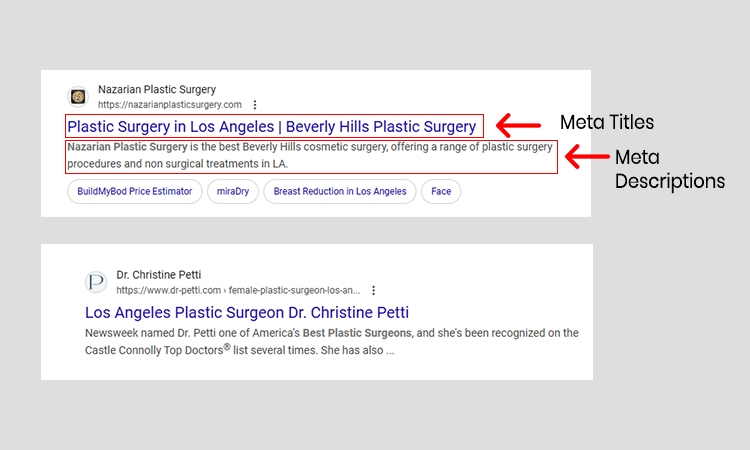
On-Page SEO is the process of optimizing individual web pages to rank higher in the search engine results and capture more relevant traffic. It includes enhancing various website elements such as content, HTTP source code, fixing broken links, optimizing title tags, improving page speed, and more. Here are a few ways you can do effective on-page SEO.
Implement Relevant Keywords
SEO is all about keywords. If you use them correctly, you are set to win. Carefully incorporate closely related keywords such as “Best cosmetic surgeons in Los Angeles” throughout your content. Here are a few ways you can perform a thorough keyword research to determine relevant keywords.
- You need to start by understanding the needs and demands of your target audience. Understand who you want to reach and what terms they are likely to use for searching your products or services.
- Implement effective Keyword research tools, such as Google Keyword Planner or SEMrush, to find relevant keywords for your ad campaign.
- You can also get ideas from Google’s “People also ask for” and “People also search for” to identify keywords that your target patients are likely to use when searching for your products or services.
- Identify a few core topics that are most relevant to your business and leverage them to determine related terms.
- You should consider using long-tail keywords as they are more specific, attract a more targeted traffic, and usually have low competition.
- Focus on keywords that actually match your content as well as the audience’s interests.
- When choosing relevant keywords, you need to consider match types such as Broad match, exact match, or phrase match. This allows you to control how closely you want the search terms to match with your keywords so that your ads appear at the top.
- For example, if you are a dermatology business, and your keyword is ”best dermatologist”, you can implement broad match types, “Top ten skin specialist doctor”, or phrase match type such as “ best dermatologist for children,” or exact match type such as “best dermatologist.”
- Avoid using irrelevant and unrelated keywords and incorporate keywords that are closely related to your practice’s products, services, or treatments.
Optimize page titles, meta descriptions, and headers
To optimize your page titles, meta descriptions, and headers, here are a few things you must remember.
Page Titles
- Make sure to include the primary keyword at the beginning of the title tag.
- You need to keep your titles under 60 characters to avoid shortening of your titles in search results.
- When creating page titles, make sure they perfectly align with your content and captivate the attention of the audience.
- Each page of your website should have a separate title tag.
- If you have space, consider adding the name of your practice for enhanced brand recognition.
Meta Descriptions:
- Meta descriptions are a crucial part of your website. Develop a short and informative summary of your page’s content and include relevant keywords.
- When creating meta descriptions for your service pages, make sure to showcase your Unique Selling Points (USPs) and Value Proposition.
- Keep your descriptions as short as possible, that is, under 120-160 characters.
- Remember to put the most crucial information at the beginning of the descriptions.
Headers:
- Include subheadings like H1, H2, H3, and H4 to enhance the readability and structure of your web pages.
- Implement closely related keywords in the headings as well
- Make sure to use the headings in a logical order to guide visitors as well as the search engines.
- Develop question-based headers to entice more readers and target featured snippets.
Include Internal Links Between Services
Adding internal links between survives is one of the most effective on-page SEO strategies. Internal links are known for enhancing user experience, helping search engines understand your website structure, and leading to higher engagement and rankings.
- Internal linking does not mean linking just anything. To boost your rankings and make your services page more engaging, link blog or an article that is relevant to that particular service. For instance, suppose you are planning to interlink something for your “Breast Augmentation” service page. Make sure to link to a blog or article that talks about the process or side effects of that particular cosmetic surgery.
- Include relevant keywords in your anchor text to make it easier for search engines to understand the linked page.
2.2 – Local SEO
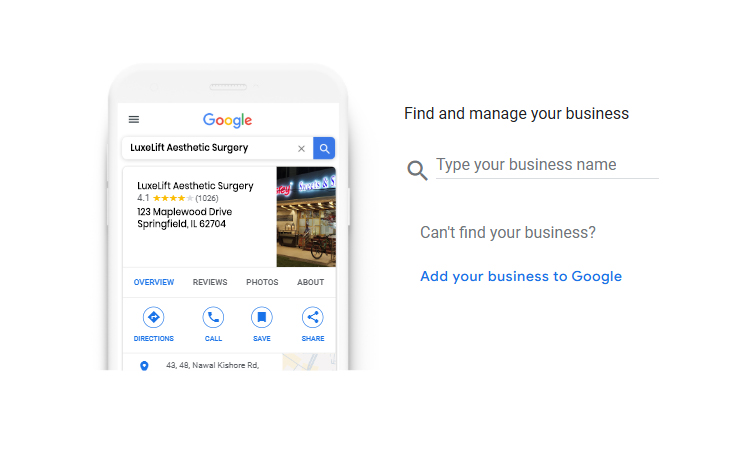
This type of SEO focuses on enhancing your online presence to attract local patients who are looking for your products or services in your area.
It not only helps businesses to rank on platforms such as Google Maps and search engine result pages, particularly when someone uses terms like “cosmetic surgery services near me” or with a specific location, such as “best plastic surgery experts in Kolkata.”
Here are some of the following steps to effectively do local SEO for your practice.
Steps to Create or Claim your Google Business Profile
Local SEO will not help if you do not have a Google Business Profile (GBP). By optimizing your GBP, you can boost your chances of appearing in the desired “local pack” on search results as well as Google Maps. This will offer a great opportunity for attracting more patients. Follow the steps below to successfully create or claim your Google Business Profile.
In case you don’t already have a Google Business Profile, go to business.google.com/add> Click on “Add your business to Google”> Add details of your business> Select a verification option.
If you already have an unverified Google Business Profile, you can claim the business profile by,
- Go to Google or Google Maps> Enter your business name or address> Click on “Own this Business”> then hit “Manage now”> If you want to choose a different business, click on “I own or manage another business”> After you are done with everything, choose a verification option.
- Add Clinic Photos, Hours, and Services
Once you are done setting up a fresh Google Business Profile for your practice, it is time to add your business details, such as pictures of your clinic, services, and operation hours.
Add photos of your business from every angle, especially the entrance. This will help build trust among your audience.
Include all the services you offer so that patients can easily see if your services align with what they are looking for.
Ensure that you update your business hours regularly, particularly during special occasions, to reflect your operating hours accurately. This helps your patients know when they should visit your clinic.
You should also add contact forms in the Contact Us section to make it easier for clients to contact you.
- Get Local Reviews and Respond to Them
Encourage satisfied patients to leave their reviews on your GBP profile and make sure to respond to them. When you respond to your patients’ reviews, it shows that you value their opinion. Positive reviews and prompt replies can help your business stand out from the others.
2.3 – Content Marketing Strategy
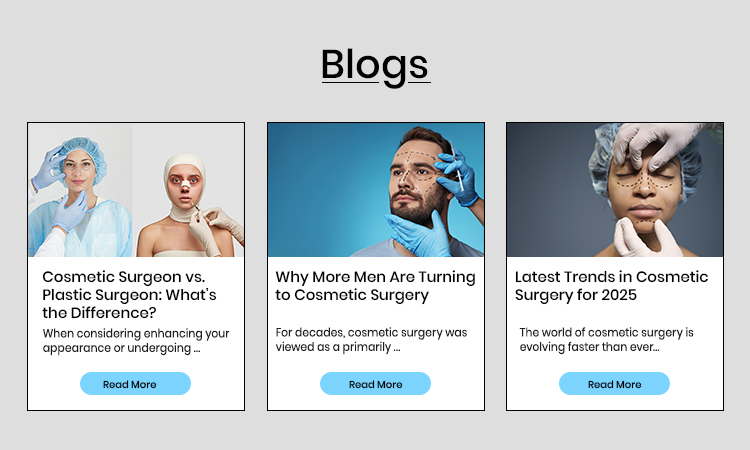
Content is the king. We all have heard this phrase once or twice, right? By developing informative, high-quality, and keyword-rich content, you can help the search engines know what your website is about, ultimately boosting your rankings and website traffic. Here is how you can create an effective content marketing strategy.
Create Informative Blog Posts
For your cosmetic surgery practice, create blog posts that are insightful to your patients. You can write blogs on the different procedures that you offer, the side effects, or the recovery process.
Create blog posts that not only answer the queries of your patients but also keep them engaged. For instance, you can write blogs such as “What to Expect After Liposuction” or “How to Choose the Right Plastic Surgery Practice in Bangalore. ” Make sure you implement simple language and provide detailed descriptions to make your blogs and articles easily readable.
Furthermore, you can also add an FAQ section to answer the queries of your patients. Now you must be thinking, how am I supposed to figure out what my target patients want? You can simply refer to the “People also ask for” and “People also search for” sections on Google.
Nowadays, more and more businesses are investing in video marketing. Make your content engaging by creating and uploading video content that discusses the process of treatment, recovery time, post-treatment care, and more, and embedding the uploaded video content on your blogs, wherever appropriate.
Implement Advanced Tools
To develop an effective content strategy, you need to implement certain tools that can make your keyword research and optimization a lot easier.
- Surfer SEO for keyword targeting
Start with keyword research for your blogs with Surfer SEO. This keyword tool can make your content rank higher on Google by
- Analyzing top-ranking pages to determine the reasons for their rankings.
- Helping your content align with what the search engine wants, so the audience can easily find your content.
- Ubersuggest or SEMrush for research
SEMrush is an all-in-one toolkit for online marketing. This platform is used by many professionals for determining relevant keywords, rank tracking, competitor analysis, and more.
Ubersuggest is a simple SEO tool that can help you find closely related keywords for your practice. Besides offering keyword suggestions, this platform also offers content reference and competitor analysis.
Step 3: Social Media Marketing
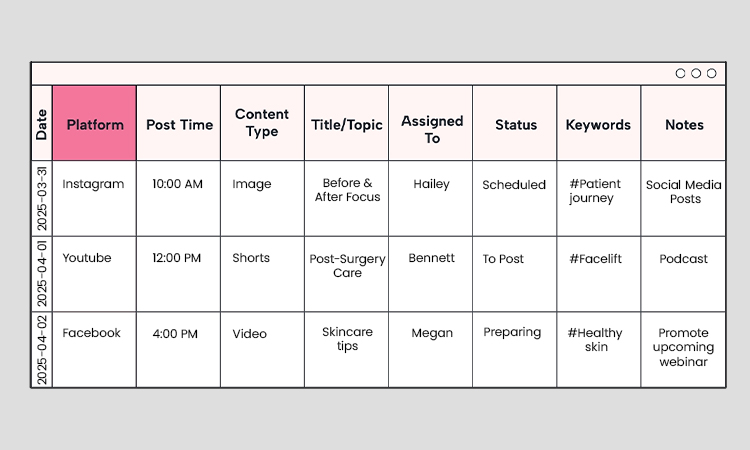
With over 5.56 billion people using social media in 2025, it is really important for businesses to establish a solid social media presence in order to get noticed by the target audience. Social media is an ideal platform for businesses to promote their offerings, educate patients, and build a community.
However, not every platform serves a similar purpose. This part of the blog will discuss various social media platforms to make it easier for you to choose the right platform.
Platforms to focus on:
Instagram can offer you an excellent opportunity for posting the before/after treatment photos and videos of your clients, while allowing you to run promotional content as well as special campaigns.
This platform has about 2 billion users, and this platform is heavily used by individuals between 18-24 and 25-30 in the United States. To meet their interests, you can create content in the form of reels and determine the concerns of your patients through Q&A sessions.
- TikTok
TikTok is one of the fastest-growing platforms designed to create and share video content.
On TikTok, you can post short videos of snippets of your treatment procedures, myths and facts, behind-the-scenes, and quick tutorials to engage target audiences.
Even if your target audience is not under 30, TikTok is still a great platform to stay updated on recent trends in cosmetic surgery and grow your practice online.
Facebook is quite a long-standing social media platform and is used by older demographics, usually individuals between 45-54. Generally, the types of posts that are preferred by Facebook’s audience are updates on your clinic, event details, promotional content, special offers, and long-form videos.
As most of Facebook’s audience consists of individuals in their 30s and 40s, they are more likely to be aligned towards non-surgical treatments.
So, posting detailed information on cosmetic surgery on Facebook can be an effective way to target the platform’s audience.
- YouTube
Cosmetic surgery practices can leverage YouTube to post educational content, such as the process of treatments, showcase patients’ testimonials, and before-and-after transformation of patients.
Furthermore, this platform is ideal for sharing behind-the-scenes or interviews with staff members to foster trust among the patients.
Posting Schedule:
Now that you know which platforms you should focus on, let us discuss how often you should post on these platforms to achieve the best results.
- YouTube:
YouTube Videos: Post at least 2-3 videos per week.
YouTube Shorts: Post approximately 3-5 shorts per week.
- Instagram:
Instagram post: Aim to post at least 3-5 times a week for higher patient engagement.
Instagram Story: Instagram story is recommended to post 2 times a day.
Instagram Reels: Aim for at least 4-6 per week.
- TikTok:
The recommended frequency to post on TikTok is 1-2 times per day.
Tools:
- Canva for graphics
We all might have heard this name. Right? Canva is a powerful and user-friendly graphic design platform that offers a wide range of images, templates, and design facets. This platform is very effective for designing captivating stories, social media posts, and more.
- Later or Metricool for scheduling
Both Later and Metricool are social media management tools that offer scheduling options. These platforms can help you to plan, schedule, and monitor your social media content across various channels.
Latter is popular for its content calendar and visual planner, while Metricool provides a complete set of advanced features such as social media analytics and integration with other platforms.
- CapCut for editing Reels
This is another popularly known platform used for editing short-form videos for TikTok and Instagram. Capcut offers an array of editing features, including text, transitions, filters, and effects, making it easier for businesses to create interactive video content.
Step 4: Paid Advertising – Google Ads & Social Ads
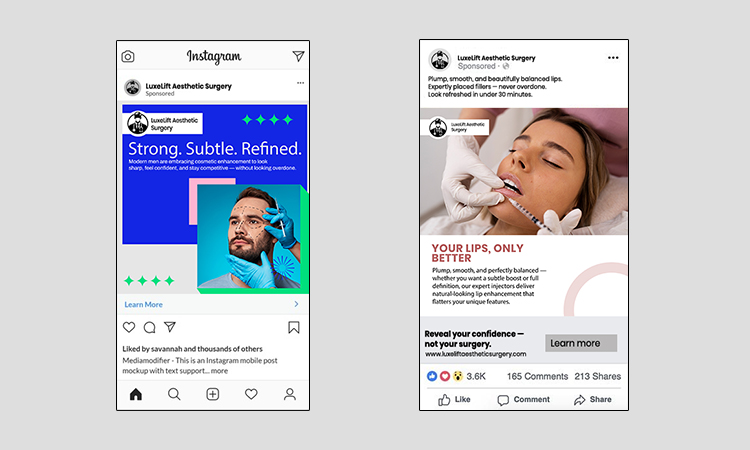
There is no denying that organic visibility is valuable. However, PPC ads can not only help with instant visibility for high-intent keywords but are also great for lead generation and converting potential leads into loyal patients. Here are some top advertising platforms where you can run ad campaigns for your business.
4.1 – Google Ads
Google Ads is one of the most popular ad platforms. This platform is a cost-effective way for businesses to reach a broader audience group. They are highly flexible; that is, you can start, pause, or stop whenever you desire to.
- Run Search Ads for keywords:
Search Ads are a form of online advertisements that appear on the Search Engine Result Pages when someone searches for specific phrases or terms that are closely related to a business’s products or services. As a cosmetic surgery business, you need to run search ads to reach patients who are actively looking for cosmetic procedures, using terms such as “Tummy tuck in Nashville” or “Botox deals near me.”
- Use location targeting
For effectively targeting your ideal patients, use location-based targeting to reach users in specific geographic areas such as Chicago, Illinois.
- Track conversions
You should monitor conversions such as phone calls, appointment bookings, and form submissions to determine the performance of your ad.
4.2 – Facebook & Instagram Ads
Meta Ads like Facebook and Instagram help businesses to achieve a targeted reach, enhance brand awareness, and cost-effective advertising.
- Target by location, age, interests
Leverage demographic and interests targeting to reach prospective audiences who are interested in beauty and wellness.
- Use short video testimonials or B&A results.
Use short video testimonials and before-and-after results of your patients to showcase the effectiveness of your cosmetic treatments.
- Test different ad copy and creatives.
Make sure to test with different ad copies and creative elements to identify the best combinations.
Budget tip:
You can start with a budget of about 15,000-30,000Rs per month and adjust your bidding based on the performance and ROI of your ad.
Step 5: Online Reputation Management
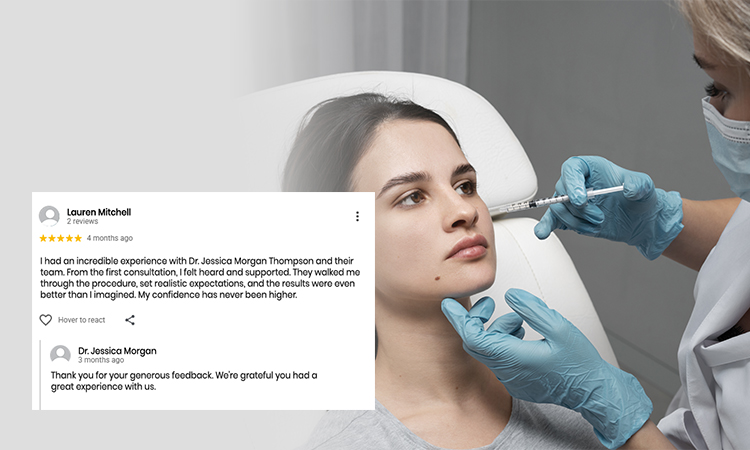
Online reputation management is the process of tracking, influencing, and determining how the public perceives an individual, brand, or entity online. Here is how you can manage your practice’s online reputation.
How to manage:
Managing your practice’s reputation is a challenging task. It needs constant monitoring of how the audience views your business. Remember, even a minor mistake can have serious consequences.
- Ask every happy patient to leave a Google review.
The best time to get a review from your patients is right after they have had a positive experience. They are satisfied, happy, and more likely to share their experiences while the visit is still fresh in their minds.
Make sure to train your front desk to gently and politely ask patients to leave their valuable reviews after undergoing a cosmetic surgery. You can also make a follow-up call to thank the patient and politely remind them to leave a review.
- Use software like Podium or Birdeye to automate review requests
For large-scale cosmetic surgery clinics, it can be really difficult to reach out to every patient manually and ask for reviews. This is where automation comes into play.
Work smart and implement software such as Podium or Birdeye to send a quick email or SMS after every patient appointment. Set it up so that when a patient leaves the clinic after a treatment, they instantly receive a thank-you message with a link to leave a Google review.
Sample Message: “Hello [Patient Name], Thank you for stopping by [Clinic Name]. We would appreciate it if you could share your experience by leaving us a quick review here: [Link]. Have a great day.”
Make sure to keep the process as seamless as possible to enhance the patient experience.
- Respond professionally to all reviews (good or bad)
Replying to every review, good or bad, shows that you care about your patients’ opinions and prioritize the reputation of your clinic.
For positive reviews, replying with a simple thank-you message will work.
“Thank you for your generous feedback. We’re grateful you had a great experience with us.”
In case of negative reviews, reply politely, calmly, and professionally. Focus on resolving the issue instead of justifying it. If possible, take it offline.
“Thank you for your valuable feedback, [Name]. We are sorry your experience didn’t meet your expectations. However, we would love to connect with you directly to make things right.”
Responding to reviews shows that you prioritize patient experience. It encourages more people to leave genuine reviews and shows future patients that you are accountable, attentive, and committed to high-quality care.
- Create testimonial videos
Testimonial videos are the secret to fostering trust among your existing as well as future patients.
Ask satisfied patients to share their experience with you, or how happy they are with the treatment, record them, and share them on your website and social platforms with proper consent.
Avoid using AI-generated videos or voices, as they can make patients lose trust in your practice.
No one would like to watch a 1-hour testimonial video. So, make sure to keep them short and impactful to keep your audience engaged.
Step 6: Email & SMS Marketing

Patients often inquire and forget. However, it is your job to remind them. For cosmetic surgeons, email marketing is one of the most powerful tools to grow their practices.
Whether you are looking to stay in touch with your existing patients or promote new services, email marketing can be a great tool to get real and measurable results. Here is how you can effectively leverage email marketing to get new patients.
Email Sequences to Set Up:
- Welcome Sequence:
Do not waste your first impression. A new subscriber should instantly enter a short welcome sequence that gives them an idea of your practice, your services, and your principles.
Remember, this is the most significant part, as this is where your email marketing either flourishes or goes down.
What to include:
- A short and warm walk-through and “what to expect.”
- Links to your most preferred cosmetic procedures.
- Patient testimonials or before-and-after videos.
- An optional offer for first-time appointment bookings.
- Pre-Consultation:
These emails can position you as an expert in your field. They are not about selling but answering the queries of interested patients. These often include FAQs or form fill-ups for booking a consultation.
Examples:
- “The difference between Botox and Fillers”
- “What are the outcomes and side effects of Liposuction?”
- Post Consultation- Follow-Ups:
This is exactly where many businesses fall short. An interested patient should be nurtured.
- Showcase your reviews.
- Offer post-surgery care tips
- Strategically incorporate urgency (e.g., “Hurry! Only 2 slots left”)
SMS Marketing:
Here is a comprehensive guide to setting up SMS marketing.
Step 1: Make sure to choose the right SMS provider, such as Twilio or Textedly. For email, you can consider using Mailchimp, Klaviyo, or ConvertKit.
Step 2: Ensure that you have prior permission to send SMS to your patients.
Step 3: Craft your messages with simple language and clear CTAs. Leverage personalized content like the name of your patient or the time of appointment.
Step 4: Integrate your SMS platforms with your calendar or booking process to send automated reminders based on scheduled appointments.
Step 5: Closely monitor the results of your SMS campaigns, leveraging the analytics offered by your chosen platform.
Step 6: Do not forget to adjust your SMS messages and timings based on your outcomes to maximize engagement and conversion rates.
Step 7: Make sure to test your messages before sending to avoid broken links or typos.
Step 8: Your text messages must be valuable to the recipient. Whether it is a special offer or an appointment reminder.
Step 7: Track Your Results

All your digital marketing efforts will go in vain if you do not track them regularly. Tracking your results can offer insights on areas of improvement as well a patient behaviour.
Here are some KPIs you must track to get maximum profit.
- Website traffic
- This metric tracks the total number of users visiting your website.
- Measures the number of visits you get on your website, with each visit considered as a session.
- Shows the total number of pages that have been viewed on your website.
- Tracks the number of visitors who have left your website after viewing just one page.
- Shows how much time users are spending on a specific webpage.
- Reveals the percentage of users who have completed an action, such as booking an appointment.
- Identifies the particular pages where visitors first enter the website.
- Measures the traffic that is coming from the search engines.
- Conversion rate
This particular KPI measures the percentage of visitors or leads coming to your website and converting into loyal patients, such as scheduling a consultation or booking an appointment.
- Cost per lead
- Cost per lead tracks the amount of money you are spending on an ad to get a single lead.
- It is calculated by dividing the total ad spend by the number of leads that were generated from those ad campaigns.
- Social Media Engagement
- This KPI measures the number of social media users who like your post.
- Identifies the number of users who save your posts.
- Shows the number of users who share your posts with their followers or friends.
- Tracks the number of posts that have seen your content.
- Measures the number of clicks the links on your posts get.
- Calculates the number of users who have engaged with your posts.
Set up a dashboard with these tools:
Google Looker Studio
It is a free tool that will allow you to link with various data sources such as Google Analytics and Google Ads. Furthermore, this tool can help you create engaging dashboards to display your KPIs systematically.
- Your CRM or booking software
Integrating your CRM or booking software with your dashboard can help you get valuable insights on patient engagement and conversions.
Step 8: Work with Experts or Build In-House

When it comes to marketing for healthcare or aesthetic businesses, you can choose one out of two options. Either building an in-house team or getting help from an expert. However, both approaches have some distinct pros and cons. So, let us discuss them.
Option 1 – Hiring an Agency
Hiring a professional Healthcare digital marketing agency for your cosmetic surgery practice offers access to a team of marketing experts with a deep understanding of healthcare marketing strategies, such as SEO, advertising, social media, email marketing, and more.
- Key questions to ask when considering an agency:
- Do they have relevant experience in healthcare or aesthetics?
- Can they show their success stories or client testimonials?
- What are their pricing structures and standard costs?
- Benefits of working with an agency:
- Have access to a broader range of specialists, including graphic designers, SEO specialists, copywriters, and more.
- Personalized approaches and quality control for achieving consistent results.
- New perspectives and advanced strategies.
- Likely to be more cost-effective in the long run by avoiding the expenses of in-house staff and tools.
- Saves time by outsourcing complicated tasks and implementing advanced tools.
- Considerations:
- Initial charges for services might be a bit higher.
- May have little control over the regular implementation of campaigns.
Option 2 – Build an In-House Team
Establishing an in-house team can allow you to have more control over your marketing activities and gain a deeper understanding of your practice and its specific challenges.
Major Roles you may need:
- Social media manager
Responsible for developing and managing content across various social media platforms, interacting with patients online, and building a strong community.
- SEO/content writer
Focuses on enhancing your online presence through thorough keyword research, content creation (press releases, blogs, articles, website copy), and technical SEO to boost search engine rankings.
- Ads specialist
Manages paid advertising campaigns on platforms like Microsoft Ads, Google Ads, Facebook Ads, and more to generate high-quality leads and boost conversion.
- Patient coordinator (for lead follow-up)
Plays a major role in lead follow-up, fostering relationships with prospective patients, and guiding them throughout the patient journey.
Benefits of setting up an in-house team:
- More control over messaging, branding, and campaign execution
- Seamless and effective communication or collaboration with internal teams, like sales or operations.
- Better understanding of the company’s values and culture.
- It may build a stronger sense of commitment and responsibility.
Considerations:
- Recruiting can be challenging, time-consuming, and expensive.
- It requires investment in training and upskilling to cope with the rapidly changing trends of the healthcare industry.
- May have limitations in specific expertise in comparison to a professional and highly skilled agency.
- Much higher overhead costs, including benefits, salaries, and tools.
Step 9: Stay Legal – HIPAA & Consent

Now you must be thinking what HIPAA compliance is, right? So, here is a detailed guide on what HIPAA is and how you can stay legal.
What is HIPAA Compliance?
It refers to the process of maintaining compliance with rules and regulations established by the Health Insurance Portability and Accountability Act (HIPAA).
HIPAA compliance is important for healthcare businesses or organizations to protect sensitive patient data to avoid penalties. Here are a few ways your practice can stay legal.
- Get written consent before using patient photos/videos
Make sure to obtain written consent before using your patient’s photos or videos for any purpose, including promotion or sharing on social media.
Once your patients approve it, you need to ensure that the process of consent and subsequent use of the photos or videos aligns with HIPAA regulations.
The consent form should clearly assert the purpose for which the photos and videos are being used and who will have access to them.
- Store data securely
You need to incorporate strong security measures to protect the data of every patient from unauthorized access, disclosure, or use.
Make sure to use encryption methods to protect data both when transmitted as well as when sorted. Limit access to patient data only to authorized sources.
- Avoid making false or misleading claims in ads
You must not make any fake or misleading claims in your ad campaigns, as doing so can lead to penalties. Make sure all the claims made in an advertisement are backed by relevant evidence, such as scientific data and studies.
You need to be transparent about your products or services and properly state any side effects or potential risks. Review all marketing materials to guarantee they are ethical, accurate, and adhere to relevant regulations.
How to Choose the Right Cosmetic Surgery Marketing Agency for Your Business
To choose the right cosmetic surgery marketing agency, here are some of the things you need to consider.
- Unparalleled Expertise
Go for an agency that has a deep understanding of cosmetic surgery marketing, its unique challenges, and patient needs. Make sure to evaluate their track record of success through patient testimonials, feedback on various review platforms, and case studies.
Remember, an agency is not good enough if it has backdated information. Choose an agency that stays updated on recent trends, ethical considerations, and regulations of healthcare marketing.
- Reputation and Reviews
Go through their social media profiles, website, and online reviews to determine their professionalism, patient satisfaction, and expertise. Consider an agency that was honoured with relevant awards and recognition within the marketing field.
- Maintain Transparency in Each Step
Make sure to choose an agency that communicates clearly and honestly about their processes, reporting, and pricing. The agency you are choosing must offer regular updates on key metrics, campaign performance, and any challenges they are facing.
Keep your queries to the agency and see if they answer your questions, resolve your concerns, and adjust their strategies based on your feedback.
- A Content-First Approach
Prioritize agencies that develop high-quality content that is resourceful to your patients. Ensure the content is tailored to your specific target audience, addressing their unique needs and concerns.
Additionally, make sure they understand and incorporate SEO to enhance your website’s visibility in the SERPs.
Conclusion
In the fast-paced digital world, digital marketing for cosmetic surgeons has become very crucial to engage, attract, and retain patients. By incorporating targeted digital marketing strategies such as SEO, PPC, email marketing, and social media, cosmetic surgery practices can build trust, showcase their expertise, and grow their practice. In case you are someone who is just starting and has no idea what to do, you can perhaps hire a professional digital marketing expert.



























